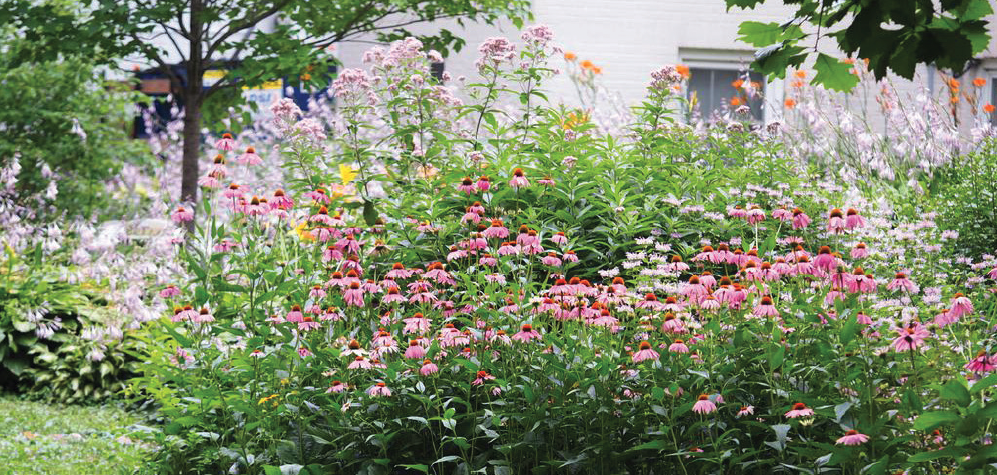The Lawns to Legumes Program was launched in 2019 as a collaboration of legislators, conservation organizations, and the public to address the rapid loss of Minnesota’s pollinator species. Minnesota Board of Water and Soil Resources Senior Ecologist and Landscape Architecture Adjunct Instructor Dan Shaw has played a key role in the development of the program, acting as program coordinator.

“This is the first statewide program in the nation to allow any resident to apply for funding and technical assistance to support pollinator populations,” explained Shaw. With $900,000 of pilot phase funding from the Environment and Natural Resources Trust Fund, the program emphasizes the establishment of habitat for the Rusty Patched Bumblebee, Monarch Butterflies, and other at-risk pollinators. Populations of these species have declined by around 80% over the last 20 years.
Drawing on Shaw’s expertise, the Lawns to Legumes Program uses the design process extensively. “We defined the environmental and social challenges to be solved, collected information, developed strategies, and allowed the program to evolve based on results. A key aspect of collecting information involved communication with a range of stakeholders. They helped guide strategies for benefitting pollinators and incorporating diversity, equity, and inclusion into decision-making,” said Shaw. Lawns to Legumes has four components:
- demonstration neighborhoods that build habitat corridors across cities or counties to support at-risk species,
- providing support to individual landowners who want to turn lawns into pollinator-friendly landscapes,
- educating the public about pollinators and pollinator gardens,
- and ensuring that consideration for program participants is equitable.
Each component fits together to provide Minnesotans with different options to participate in conservation.
The program also focuses on the aesthetics of recommended plantings to make it easy for community members to incorporate them into residential landscapes.
The program’s Planting for Pollinators Habitat Guide, which was a collaboration with student Alexandra Boese (Landscape Architecture), emphasizes this approach. It subsequently won an ASLA Minnesota Merit award. Boese also designed planting templates for Shady Gardens (pdf), Rain Gardens (pdf), Sunny and Low (Boulevard) Gardens (pdf), and the program’s logo.
Shaw’s work with the program has become a helpful case study for his College of Design classes. “This project demonstrates how to build an initiative to address environmental and social challenges. I’m able to share strategies that have been successful for establishing the program and maintaining its momentum. There are also other important lessons from the program about building ecological and social connections across landscapes and how to design projects that provide a wide range of environmental benefits,” said Shaw.
The program will fund 2,000 new projects this spring. Shaw hopes to have over 200 volunteer coaches trained as mentors and to open program webinars to anyone in the state. “New funding sources will also create opportunities to establish projects within community spaces and ensure that residents in all parts of Minnesota have an opportunity to get involved. We see these as important steps to continue building a movement to protect pollinators and address other challenges,” concluded Shaw.
Photo courtesy of Metro Blooms.
Lawns to Legumes Pilot Phase Achievements:
- 3.5 million total square feet of pollinator habitat created
- 3,000 grant-funded plantings completed by Minnesota residents (923 in environmental justice areas)
- 5,000–10,000 DIY projects supported
- 27 Demonstration Neighborhoods established
- 18,000 applications received for individual support grants
- 148 volunteer coaches recruited
- 128 pollinator habitat workshops held attended by 5,745 people
- 340,000 program website visits
- Recipient of the Environmental Initiative Award for Large-Scale Sustainability Impacts.
Longtime professor, mentor, and leader in the Twin Cities design community Joe Favour (B.L.A. ’92) began his appointment as head of the Department of Landscape Architecture this June.
A project years in the making, eFargo is an interactive game that teaches users about carbon emissions and helps them reduce energy use in the real world. Developed by a team of faculty and students from the College of Design and North Dakota State University (NDSU), the project was initially created and has subsequently been led by Associate Professor Malini Srivastava (Architecture). The project has won numerous awards, including the highly competitive 2022 R+D Award from Architect Magazine.
For residents of rural Minnesota, eating sustainably year-round can be a challenge. This spring, a graphic design class created posters to promote a key link in the local food chain: small grocery stores.





